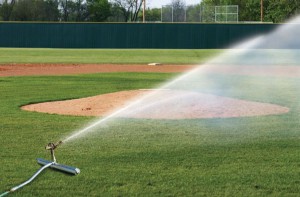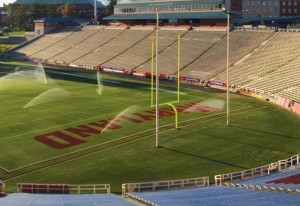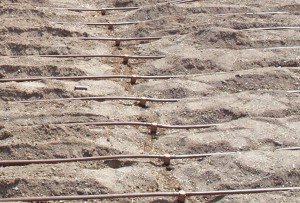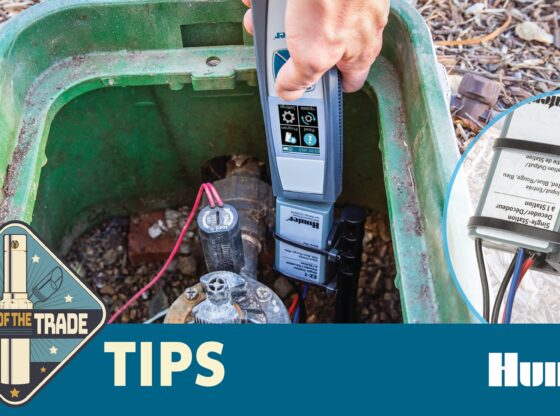Unless you are a professional sport team, budgets are always tight for those who maintain sport field irrigation. Yet there are options to help stretch tight budgets and get the irrigation job done.
First step is to have a plan! Know where you need to get to then buy equipment. Otherwise investments are often wasted. Let’s look at the options starting with the least cost.
Solid Set
Solid set systems are manually moved sprinklers. Often impact sprinklers mounted on hose or tripod stands.
Can be inexpensive. Allow a high degree of flexibility and portability. But are labor and time intensive. The time issue may be a problem during extended drought periods. Sport field irrigation users find themselves unable to keep up with the irrigation demand.
Water supply: At least 7 gpm, larger water supplies allow more sprinklers to run at a time.
Pressure: At least 45 psi, but 60 to 75 psi allows a wider selection of sprinklers and run distances. Will often need a small booster pump to achieve a workable operating pressure.
Mainline Pipe: 1” minimum for up to 2 sprinklers. If installing pipe, install at least 2” in case you can use irrigation machines or in ground systems later on.
Cost: Can be cheap. $500 to $2,000 depending on how much pipe, hose, or if a pump is required.
Small Travelling Systems
Essentially like a solid set sprinkler, but mounted on a small travelling unit. Decreases labor time to set up and move. Less labor, small amount of additional costs.
Unit follows a wire and drags a hose behind. Will take 3 runs to do a football field. Each run will take about 3-4 hours.
Water Supply: Minimum 13 gpm. Larger sprinkler may need up to 25 gpm.
Pressure: Plan for 65 psi minimum. Would suggest 75 psi. Probably means a small booster pump is needed.
Mainline Pipe: 1 ¼” pipe minimum. Again, suggest installing 2” for future needs. Use 1” hose to feed unit from a quick coupler valve on mainline.
Cost: $2,000, plus ancillary piping and hose.
Large Travelers
A drum with HDPE pipe wrapped on it. Sprinkler is mounted on a sled or cart. Sled is pulled out with a small tractor or utility cart. Drum revolves and winds the pipe in as it irrigates. Link to Bauer.
Water is best delivered via buried mainline to a hydrant. A hose (1 ½ to 2”) feeds water to traveller location. Booster pumps can be gasoline driven and mounted on the traveler unit.
Larger sprinklers can be used to cover more ground per run than small traveler units. Can do a football field in 2 runs. Like solid set or small travelers, units can be transported to other fields and sites.
Water Supply: 15 gpm minimum. 25 to 30 gpm ideal.
Pressure: Pressure drives the drum retraction and the sprinkler. Will need 75 psi minimum for good operation. Booster pumps commonly installed at the water source or gasoline powered on the traveler unit.
Mainline Pipe: 2” pipe minimum. Many users will run 2-3 units at a time. Figure 3” mainlines if that’s the case.
Cost: About $7,000 for smaller units (good for most sport fields) up to $16,000 for larger. Plus piping and pumps, as needed.
In Ground Systems
Highest cost, but least amount of labor. In ground systems are not transportable, every field will have its own system. Link to Rain Bird.
Can be highly automated. Advance control systems schedule irrigation based on site weather conditions an can be remotely monitored and operated. Very little time requirement and uses least amount of water.
Sprinkler layout should be designed to cover high stress areas separately from low stress. Sprinklers are special for sport turf. Allows lower than sod level installation with rubber tops to avoid play interference and player injury.
All components, other than the control devices, are below ground. Well installed systems are virtually invisible.
Water Supply: Commonly designed around 55 gpm per field.
Pressure: Sport turf sprinklers work best around 75 psi. Systems should be supplied 85 psi or a little more to cover pressure losses through the piping network. Almost always requires a booster pump.
Mainline Pipe: 2” mainline are sufficient for one field. If multiple fields are being supplied and simultaneously operated by the mainline, large pipe and water supply will be required.
Cost: Depending on the type of field and the layout, will start at $9,000 up to $15,000 per field. Pumps and water supplies may add to that cost.
Sub-Surface Micro
Pressure regulated in-line emitter tubing installed in the turf root zone every 18 to 24”. A new way to irrigate sport turf that is being experimented with across the nation. Link to NetaFim.
Most users and many irrigation people are not yet sold on the concept, but promoters say the results have been good so far. Nearby for us is a field in Indianapolis in operation now for about 4 years. Something to watch for the future.
As mentioned, to avoid wasting money on abandoned equipment, have a plan. Users commonly start a concept and add to it over a few years to reduce the capital outlay in a given year. You just need to know where you want to end up.
Water supply is the common bug-a-boo for sport field irrigation. We need a good amount of flow to irrigate a large area quickly. Example; to apply a 1/2 “of water to an acre will take 4 hours with a 2” mainline or 14 hours with a 1” mainline. We always want a larger water source than is typically available!












Hello,
I really very informative blog about the Sports field irrigation, I read your articles many times and bookmark your page.
Thank you so much for sharing this Great knowledge.
Keep It up, dude,
Nice post. I was checking constantly this weblog and I am inspired!
Extremely helpful info specifically the closing part 🙂 I maintain such information much.
I used to be seeking this particular info for a long time.
Thank you and good luck.
whoah this blog is wonderful i like reading your articles.
The feature of this water injection machine extremely convenient. Thank you